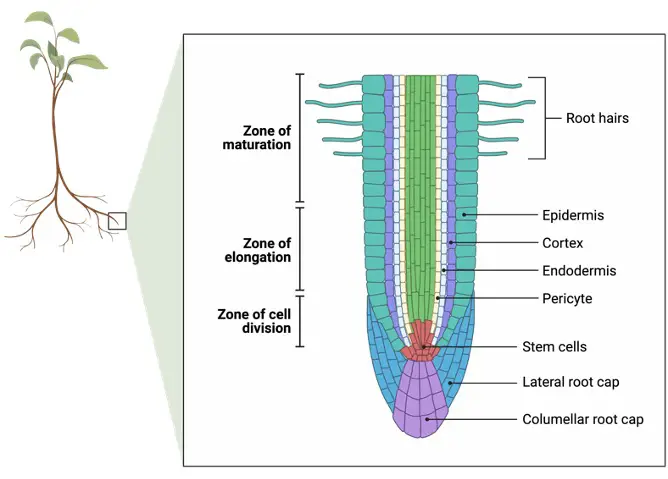Table of Contents
What is Plant Meristem?
Many people confuse an increase in size with an increase in growth but both are different from each other. An irreversible increase in the number of cells and especially in its dry mass is defined as growth. The fluctuating levels of water in organisms at different points make “fresh mass” the inaccurate indicator, therefore dry mass is used to calculate growth.

Meristem is the areas within the plant in which growth occurs. It includes unspecialized cells that perform repeated cell divisions. With the process of cell differentiation, these unspecialized cells become specialized cells to perform specific functions. Meristems are classified into two types: lateral and apical.
i. Apical Meristems
The primary growth of a plant occurs in apical meristems that can be found at the root and shoot tips. The unspecialized cells of meristem become specialized according to the specific function they will perform in the plant. The whole process undergoes the following steps:
• The unspecialized cell provides a site of mitosis and undergoes division.
• After elongation of these cells, they undergo vacuolation.
• The process of cell differentiation occurs to differentiate the cells to perform a specific function.
• They become a part of permanent tissue and perform a particular role within the plant.
• To maintain the growth and regeneration of the plant, the cycle is continuous.
ii. Lateral Meristems
Lateral meristems help in the lateral growth of a plant. They are responsible for the secondary thickening of perennial plants and provide structural support to the plant. The plant grows wider in girth by the formation of the cambium rings. The girth is wider in larger plants that support the plant upright.
Layers of new living mass were formed outwards by cambium tissue. The outermost layer is generally formed by cork cambium, which provides protection against pathogens. The formation of vascular bundles also occurs that helps in the transportation of resources such as water and minerals.
The medullary rays are formed by parenchyma cells and reach out laterally across a plant. These rays help to transport water in outer regions. The lenticels formed in between the small gaps help in gaseous exchange in the plant. The inner areas of cambium provide minerals and water and CO2 comes from the immediate external environment.
Annual Rings
The growth of lateral meristem in plants is executed much faster in summer. The reasons behind this are as follows:
• The plant gets more daylight hours in summer that helps it to perform more photosynthesis.
• Plant get more intense and direct sunlight in summers.
• Availability of biological matter such as insects is at its greatest in summer that provides essential mineral contents for growth.
• Due to suitable temperatures, biological reactions occur more efficiently.
All these favorable conditions stimulate the growth of the plant in summers. The conditions are totally opposite in winters that affect cell growth. The conditions are less favorable in winters therefore the cell grows over a smaller volume of the area, which appears like rings to the human eye. These rings are used to calculate the age of the tree. Thus the cambium rings formed in winters are used to deduce the age of the tree.
Nucleotide Citations
- Plant meristems: what you see is what you get? Curr Biol . 2006 Jan 24;16(2):R56-8.
- Plant primary meristems: shared functions and regulatory mechanisms. Curr Opin Plant Biol . 2010 Feb;13(1):53-8.
- Plant Inflorescence Architecture: The Formation, Activity, and Fate of Axillary Meristems. Cold Spring Harb Perspect Biol . 2020 Jan 2;12(1):a034652.
- Figures are created with BioRender.com







